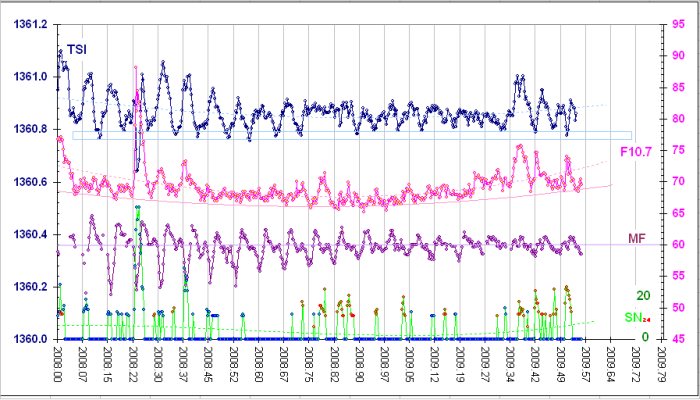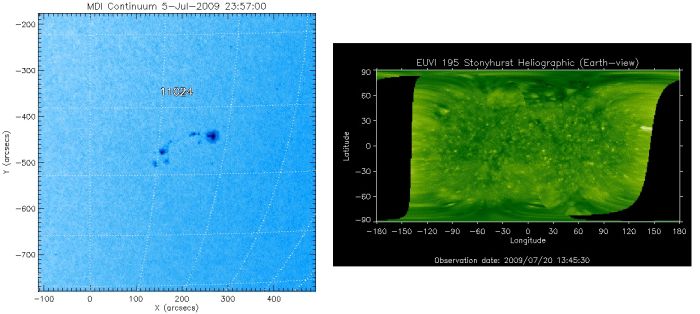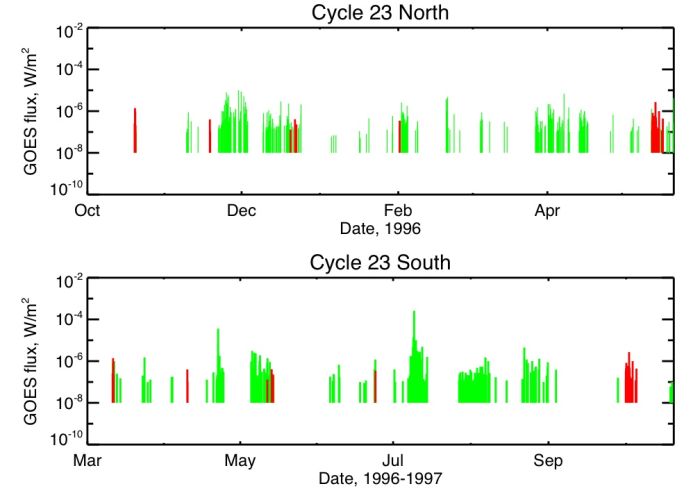Where are the flares
| Where are the flares? | |
|---|---|
| Number: | 106 |
| 1st Author: | Hugh Hudson |
| 2nd Author: | and Leif Svalgaard |
| Published: | 21 July 2009 |
| Next Nugget: | NUGGET 107 |
| Previous Nugget: | The 15.11 MeV Gamma-ray Line Detected? |
Introduction
In Nugget 99 three months ago, we remarked on the slow development of Solar Cycle 24. In the meantime there has been one pretty good active region (on about July 4!) and it produced one C-class flare, but at the time of writing the question still stands - where are the flares? In that previous Nugget we started with a superposed-epoch analysis keying on the solar maxima over the last five cycles, during which there is modern data. In this Nugget we assume that we have detected the Cycle 23/24 minimum and can key on its epoch, which we take to be December 2008. The evidence for this is in Figure 1 below. An earlier version of this figure appeared in the earlier Nugget, and even newer ones will be posted here regularly.
Some activity
As the sunspot number in Figure 1 shows, a burst of activity has just happened - see the blue-green sunspot numbers at the bottom of the plot. The spot group itself is in Figure 2 (left) as cut and pasted from the images on the convenient SolarMonitor Web site; as Figure 1 shows this was the biggest spot group for more than one year, and it produced a C-class flare event as well. It goes without saying that Americans should proudly note its coincidence with the Fourth of July! On the other hand, the right panel of Figure 2 shows "Stonyhurst" view, as of July 20, of almost the whole solar surface reprojected from the three views obtained by the two STEREO spacecraft and SOHO. The spots have gone, or at least they have not left much of a (magnetic) trail behind, and nothing new has appeared. The right-hand panel of Figure 2 shows a Sun that is essentially undistinguishable from that at solar minimum
We are pretty sure that something unusual is happening and that the Sun is behaving in a manner that is possibly even unique in the existing record. However the gradual upturn in the F10.7 index, our most reliable and quantitative measure of global solar activity, is clear - from a daily value of about 66 solar radio flux units (10-22 W/m2>Hz) it has risen perceptibly to almost 70. So there seemingly is a new Cycle 24, but where are the flares?
Where are the flares?
To learn whether the new cycle is starting properly (from RHESSI's point of view, as a flare mission, "properly" means having some nice solar flares to study), we compare with the previous cycle onset. The previous solar minimum appeared at different epochs in the two hemispheres (ref. [1]), so we have taken each of these epochs and plotted the GOES flare events in the current rise phase relative to those epochs. The results are in Figure 3. The epochs (March 1996 and October 1996 differed by seven months, and the time range overplotted is seven months and 21 days between Dec. 1 2008 and the time of writing. The flares of the current epoch are in red, and the flares of the two earlier epochs are in green. Clearly the burst of activity around July 4th is as it should be, but equally clearly there is a vast difference between the flare occurrences in either of these epochs. This is presumably consistent with the lack of spot activity and so it was expected, but in terms of flare occurrence (the "cracking of the whip" of solar activity?) the differences are striking.


